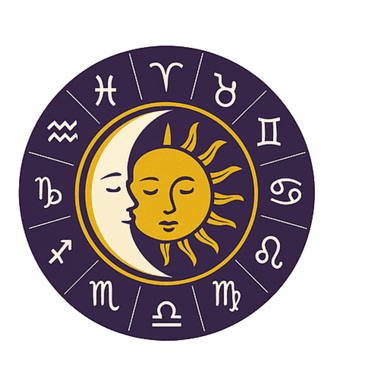The Timeless Story of the Sun (Surya) in Vedic Astrology

Chariot of Seven Horses and Symbolism
Surya is classically depicted riding a golden chariot, drawn by seven horses—representing the seven days of the week and the visible spectrum of light. His charioteer is Aruna, the personification of dawn, who arose to help shield the worlds from Surya’s wrath after the confrontation with Rahu (see below). The seven horses also correspond to the seven chakras, emphasizing the Sun’s power over both the physical and spiritual nerves of creation.
Myths from Vedic and Puranic Classics
The Shadow and Splendor: Sangya, Chhaya, and Saturn
A widely told Puranic tale features Surya’s wife, Sangya (Sanjna), the daughter of Vishwakarma (divine architect). Unable to bear Surya’s fierce brilliance after birthing three children—Yama (Death), Yamuna (River Goddess), and Tapati—she leaves, fashioning her shadow Chhaya as her substitute. Surya, not noticing at first, lives with Chhaya, with whom he fathers Saturn (Shani) and others. Only when Chhaya curses Yama does Surya discover the truth. To reunite with Sangya, who has disguised herself as a mare in a distant forest, Surya transforms into a horse. Their union there produced the Ashwini Kumars (twin gods of Ayurveda).
Overwhelmed by his radiance, Sangya seeks her father Vishwakarma’s help. Vishwakarma grinds the Sun on a stone, reducing his brightness by one-eighth, making Surya’s presence endurable—a portion of this divine energy becomes the weapons of other gods (Vishnu’s discus, Shiva’s trident, etc.).
The Origin of Eclipses: Surya and Rahu
After the Samudra Manthan (Churning of the Ocean), when the gods and demons vied for the nectar of immortality, Rahu disguised himself among the gods to drink Amrita. Surya and Chandra exposed Rahu, alerting Vishnu, who decapitated Rahu. The immortal head (Rahu) became a shadow planet, and in vengeance, periodically swallows Sun and Moon, causing eclipses.
Surya’s Role Among Gods and in Epics
Surya is not only the father of Yama and Shani but also Karna (the heroic son from Mahabharata), Sugriva (monkey chief in Ramayana), Saturn (Shani), and the Aswini Kumaras. These relationships symbolize Surya’s connection to law, medicine, discipline, and heroism.
Surya in Vedic Ritual and Upanishads
Surya is venerated in rituals like Sandhya Vandana (twilight worship) and Surya Namaskar (Sun Salutations). In Upanishadic philosophy, the Sun transitions from an external deity to an inner principle—the eye of consciousness, the sight and insight by which the seer discovers the Atman (Self).
Astrological and Spiritual Significance
In Vedic astrology (Jyotisha), the Sun rules the sign Leo (Simha), governs the east, Sunday (Ravivar), the bones, the father, authority, the 10th and 9th houses, and the core of self-esteem, power, and destiny. Surya is considered the king of the planetary cabinet. A strong Sun gives leadership, vitality, and clarity; a weak or afflicted Sun may reduce self-esteem and cause health or status issues.
The Cosmic Role of the Sun: Soul and Illumination
Surya, in Hindu cosmology, is known as the dispeller of darkness and bringer of light. He is worshipped not just for physical health and abundance, but as a representation of the inner sun—the undying spirit that eradicates ignorance and brings enlightenment. The Sun’s journey through the sky is seen as the supreme yogi’s relentless spiritual practice, maintaining cosmic rhythm despite all adversities.
Conclusion
The story of the Sun in Vedic astrology is a tale of cosmic radiance, sacrifice, transformation, and dharma. From the primordial hymns of the Rigveda to epic Puranic legends, Surya’s myths serve as metaphors for the inner spiritual journey—processing challenges, shedding unnecessary brilliance, and ultimately shining for the good of all creation. As the source of life, law, and enlightenment, Surya’s planetary story continues to inspire seekers on the path to self-realization and truth.
